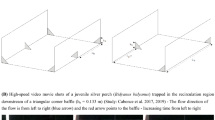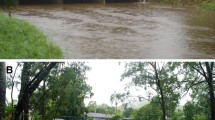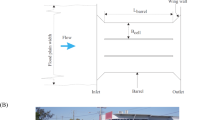Abstract
A culvert is a covered channel to pass streams and floodwaters through an embankment. The ecological impact of culverts has been recognised, in particular in terms of stream connectivity, but existing guidelines lead often to un-economical culvert design. Herein, a small triangular corner baffle system was tested physically in a near-full-scale fish-friendly facility of a box culvert barrel. Experiments were repeated with several configurations to characterise the flow properties for a range of less-than-design flows, baffle sizes and spacings. In presence of triangular corner baffles, the flow was asymmetrical, owing to the wake behind each baffle. The presence of triangular corner baffles had a moderate effect on the flow resistance and discharge capacity, albeit the data indicated the combined effect of relative baffle height and spacing on the friction factor. With triangular baffles, the surface area of slow velocity regions increased by a factor of two to three. Such low velocity regions are preferential swimming zones for fish, beneficial to small-bodied fish passage. Testing with small-bodied fish showed that fish preferred to swim upstream in slow-velocity regions, typically next to the sidewalls and in the left corner where the triangular baffles were located. The presence of small triangular baffles facilitated substantially the upstream passage of small fish, including in terms of endurance, compared to a smooth un-baffled box culvert barrel, when the baffle size was comparable to the fish length. The present findings highlighted the importance of physical modelling at near full-scale for the development of fish-friendly culvert designs.











Similar content being viewed by others
Abbreviations
- PVC:
-
Polyvinyl chloride
- s:
-
Second
- h:
-
Hour
- min:
-
Minute
- B:
-
Channel width (m)
- DH :
-
Hydraulic diameter (m)
- d:
-
Water depth (m)
- dc :
-
Critical flow depth (m)
- d1 :
-
Inflow depth (m)
- Fr:
-
Froude number; for a rectangular channel: \(Fr = \frac{\text{V}}{{\sqrt {{\text{g}} \times {\text{d}}} }}\)
- f:
-
Darcy–Weisbach friction factor
- fskin :
-
Skin friction factor measured with a Prandtl–Pitot tube lying on the bed
- f′:
-
Skin friction factor
- g:
-
Gravity acceleration (m/s2): g = 9.794 m/s2 in Brisbane, Australia
- H:
-
Internal barrel height (m)
- hb :
-
Triangular baffle height (m)
- K:
-
Head loss coefficient
- ks :
-
Equivalent sand roughness height (m)
- L:
-
Channel length (m)
- Lb :
-
Longitudinal spacing (m) between baffles
- Lt :
-
Turbulent length scale (m)
- lm :
-
Mixing length (m)
- Mo:
-
Morton number
- N:
-
Velocity power law exponent
- Q:
-
Water discharge (m3/s)
- Qdes :
-
Design discharge (m3/s) of culvert structure
- P:
-
Pressure (Pa)
- R:
-
Normalised correlation coefficient
- Re :
-
Reynolds number defined in terms of the hydraulic diameter: Re = ρ×Vmean×DH/μ
- So :
-
Bed slope: So = sin θ
- Tt :
-
Turbulent time scale (s)
- V:
-
Flow velocity (m/s) positive downstream
- Vb :
-
Velocity (m/s) measured by a Pitot–Prandtl–Preston tube lying on the bed
- Vc :
-
Critical flow velocity (m/s)
- Vfs :
-
Free-surface velocity (m/s)
- Vmax :
-
Maximum velocity (m/s); free-stream velocity (m/s) above boundary layer
- Vmean :
-
Cross-sectional mean velocity (m/s): Vmean = Q/(B×d); also called bulk velocity
- V1 :
-
Inflow velocity (m/s)
- Vx :
-
Longitudinal velocity component (m/s)
- V′:
-
Velocity fluctuation (m/s)
- X:
-
Relative distance between baffles: X = (x − xb)/Lb
- x:
-
Longitudinal distance (m) positive downstream
- xb :
-
Longitudinal baffle position (m)
- YVmax :
-
Transverse distance (m) where Vx = (Vmax)M
- y:
-
Transverse distance (m) measured from the right sidewall positive towards the left sidewall
- ZVmax :
-
Vertical elevation (m) where Vx = Vmax
- z:
-
Vertical distance (m) positive upwards with z = 0 at the invert
- zb :
-
Elevation (m) of Prandtl–Pitot tube dynamic tapping when the tube is lying on the bed
- ΔH:
-
Manometer reading (m)
- δ:
-
Boundary layer thickness (m)
- κ:
-
von Karman constant: κ = 0.4
- μ:
-
Dynamic viscosity (Pa.s) of water
- νT :
-
Eddy viscosity (m2/s)
- θ:
-
Angle between bed slope and horizontal
- ρ:
-
Water density (kg/m3)
- σ:
-
Surface tension (N/m) between air and water
- τo :
-
Skin friction boundary shear stress (Pa)
- Ø:
-
Diameter (m)
- M:
-
Cross-sectional maximum value
- max:
-
Maximum value in a vertical profile
- skin:
-
Skin friction
- x:
-
Longitudinal direction positive downstream
- 1:
-
Upstream flow conditions
References
Apelt CG, Xie Q (2011) Measurements of the turbulent velocity field in a non-uniform open channel. In: E Valentine, C Apelt, J Ball, H Chanson, R Cox, R Ettema, G Kuczera, M Lambert, B Melville, J Sargison (eds) Proc. 34th IAHR World Congress, Brisbane, Australia, 26 June–1 July, Engineers Australia Publication, pp 3338–3345. ISBN: 978-0-85825-868-6
Barenblatt GI (1994) Scaling, phenomena in fluid mechanics. Inaugural Lecture Delivered before the University of Cambridge on 3 May 1993, Cambridge University Press, UK, 49 pp
Behlke CE, Kane DL, McLeen RF, Travis MT (1991) Fundamentals of culvert design for passage of weak-swimming fish. Report FHW A-AK-RD-90-10, Department of Transportation and Public Facilities, State of Alaska, Fairbanks, USA, 178 pp
Cabonce J, Fernando R, Wang H, Chanson H (2017) Using Triangular baffles to facilitate upstream fish passage in box culverts: physical modelling. Hydraulic Model Report No. CH107/17, School of Civil Engineering, The University of Queensland, Brisbane, Australia, 130 pp
Cahoon JE, McMahon T, Solcz A, Blank M, Stein O (2007) Fish passage in Montana Culverts: Phase II—passage goals. Report FHWA/MT-07-010/8181, Montana Department of Transportation and US Department of Transportation, Federal Highway Administration, 61 pp
Chanson H (2000) Boundary shear stress measurements in undular flows: application to standing wave bed forms. Water Resour Res 36(10):3063–3076. https://doi.org/10.1029/2000WR900154
Chanson H (2002) Hydraulics of a large culvert beneath the Roman aqueduct of Nîmes. J Irrig Drain Eng ASCE 128(5):326–330. https://doi.org/10.1061/(ASCE)0733-9437(2002)128
Chanson H (2004) The hydraulics of open channel flow: an introduction, 2 edn. Butterworth-Heinemann, Oxford. ISBN: 978-0-7506-5978-9
Chanson H (2014) Applied hydrodynamics: an introduction. CRC Press, Leiden. ISBN: 978-1-138-00093-3
Chorda J, Larinier M, Font S (1995) Le Franchissement par les Poissons Migrateurs des Buses et Autres Ouvrages de Rétablissement des Ecoulements Naturels lors des Aménagements Routiers et Autoroutes. Etude Expérimentale. Rapport HYDRE n°159 - GHAAPPE n°95-03, Groupe d’Hydraulique Appliquée aux Aménagements Piscicoles et à la Protection de l’Environnement, Service d’Etudes Techniques des Routes et Autoroutes, Toulouse, France, 116 pp (in French)
Cotel AJ, Webb PW, Trittico H (2006) Do brown trout choose locations with reduced turbulence? Trans Am Fish Soc 135:610–619
Darcy HPG (1858) Note relative à quelques modifications à introduire dans le tube de Pitot. Annales des Ponts et Chaussées XV:351–359 & 1 plate (in French)
Darrozes SS, Monavon A (2014) Analyse Phénoménologique des Ecoulements. Comment traiter un Problème de Mécanique des Fluides avant de résoudre les Equations. (‘Phenomenological Analysis of Flows. How to solve a Fluid Mechanics Problem before solving the Equations.’) Presses Polytechniques et Universitaires Romandes, Lausanne, Switzerland, 480 pp (in French)
Djenidi L, Elavarasan R, Antonia RA (1999) The turbulent boundary layer over transverse square cavities. J Fluid Mech 395:271–294
Fairfull S, Witheridge G (2003) Why do fish need to cross the road? Fish passage requirements for waterway crossings. NSW Fisheries, Cronulla NSW, Australia, 14 pp
Foss JF, Panton R, Yarin A (2007) Nondimensional representation of the boundary-value problem. In: Tropea C, Yarin AL, Foss JF (eds) Springer handbook of experimental fluid mechanics. Part A, Chapter 2. Springer, pp 33–82
George WK (2006) Recent advancements towards the understanding of turbulent boundary layers. AIAA J 44(11):2435–2449
Hee M (1969) Hydraulics of culvert design including constant energy concept. In: Proc. 20th Conf. of Local Authority Engineers, Dept. of Local Govt, Queensland, Australia, paper 9, pp 1–27
Helmholtz HLF (1868) Über discontinuirliche Flüssigkeits-Bewegungen. Monatsberichte der königlich preussichen Akademie der Wissenschaft zu Berlin, pp 215–228 (in German)
Henderson FM (1966) Open channel flow. MacMillan Company, New York
Herr LA, Bossy HG (1965) Hydraulic charts for the selection of highway culverts. Hydraulic Eng. Circular, US Dept. of Transportation, Federal Highway Admin., HEC No. 5, December
Howe JW (1949) Flow measurement. In: Rouse H (ed) Proc 4th Hydraulic Conf., Iowa Institute of Hydraulic Research. Wiley, pp 177–229
Hunt M, Clark S, Tkach R (2012) Velocity distributions near the inlet of corrugated steep pipe culverts. Can J Civ Eng 39:1243–1251
Larinier M (2002) Fish passage through culverts, rock weirs and estuarine obstructions. Bulletin Français de Pêche et Pisciculture 364(18):119–134
Liggett JA (1994) Fluid mechanics. McGraw-Hill, New York
Lupandin AI (2005) Effect of flow turbulence on swimming speed of fish. Biol Bull 32(5):461–466
Macintosh JC (1990) Hydraulic characteristics in channels of complex cross-section. Ph.D. thesis, University of Queensland, Department of Civil Engineering, Australia, November, 487 pp. https://doi.org/10.14264/uql.2015.218
Macintosh JC, Isaacs LT (1992) RPT—The Roving Preston Tube. In: Proc. 11th Australasian Fluid Mechanics Conference, 11AFMC, Hobart, Australia, vol II, Paper 8E-1, pp 1049–1052
Monk SK, Wait LE, Hotchkiss RH, Billman E, Belk M, Stuhft D (2012) Culvert roughness elements for native Utah fish passage. In: Proc. World Environmental and Water Resources Congress, ASCE, Albuquerque NM, USA, 20–24 May, pp 1301–1307
Morris HM (1955) A new concept of flow in rough conduits. Trans ASCE 120:373–410
Nezu I, Rodi W (1985) Experimental study on secondary currents in open channel flow. In: Proceedings 21st IAHR Biennial Congress, Melbourne, Australia, pp 114–119
Novak P, Cabelka J (1981) Models in hydraulic engineering. Physical principles and design applications. Pitman Publ., London
O’Connor C (1993) Roman bridges. Cambridge University Press, Cambridge
Olsen A, Tullis B (2013) Laboratory study of fish passage and discharge capacity in slip-lined, baffled culverts. J Hydraul Eng ASCE 139(4):424–432
Patel VC (1965) Calibration of the Preston tube and limitations on its use in pressure gradients. J Fluid Mech 23(Part 1):185–208
Preston JH (1954) The determination of turbulent skin friction by means of Pitot tubes. J R Aeronaut Soc Lond 58:109–121
Quadrio J (2007) Passage of fish through drainage structures. Queensland Roads, pp 6–17
Schlichting H (1979) Boundary layer theory, 7th edn. McGraw-Hill, New York
Streeter VL (1948) Fluid dynamics. McGraw-Hill Publications in Aeronautical Science, New York
Troskolanski AT (1960) Hydrometry: theory and practice of hydraulic measurements. Pergamon Press, Oxford
Wang H, Chanson H (2017) How a better understanding of Fish-Hydrodynamics Interactions might enhance upstream fish passage in culverts. Research Report No. CE162, School of Civil Engineering, The University of Queensland, Brisbane, Australia, 43 pp. ISBN: 978-1-74272-192-7
Wang H, Chanson H (2018) Modelling upstream fish passage in standard box culverts: interplay between turbulence, fish kinematics, and energetics. River Res Appl 34(3):244–252. https://doi.org/10.1002/rra.3245
Wang H, Chanson H, Kern P, Franklin C (2016) Culvert hydrodynamics to enhance upstream fish passage: fish response to turbulence. In: Ivey G, Zhou T, Jones N, Draper S (eds) Proceedings of 20th Australasian Fluid Mechanics Conference, Australasian Fluid Mechanics Society, Perth WA, Australia, 5–8 December, Paper 682, 4 pp
Wang H, Uys W, Chanson H (2018) Alternative mitigation measures for fish passage in standard box culverts: physical modelling. J Hydro-environ Res 19:214–223. https://doi.org/10.1016/j.jher.2017.03.001
Webb PW, Cotel AJ (2011) Stability and turbulence. In: Encyclopedia of fish physiology: from genome to environment, vol 1–3. Academic Press, San Diego, pp 581–586. https://doi.org/10.1016/b978-0-12-374553-8.00221-5
Acknowledgements
The authors thank Dr. John Macintosh (Water Solutions, Australia), Dr. Brian Crookston (Schnabel Engineering, USA) and Tony Marszalek (HEC Hydro Engineering & Consulting, Australia) for valuable comments. They acknowledge the helpful assistance of Jee Sam Tiew, Jui Jie Tan, Angela Arum, Michael Cheung and Thi My Tram (Stephanie) Ngo (The University of Queensland, Australia) in collecting physical data. They thank Xinqian (Sophia) Leng and Urvisha Kiri (The University of Queensland, Australia) for their inputs. The authors acknowledge the technical assistance of Jason Van Der Gevel and Stewart Matthews (The University of Queensland). The assistance of Dr. Jabin Watson and Prof. Craig Franklin (The University of Queensland) with fish testing is acknowledged. The financial support through the Australian Research Council (Grant LP140100225) and the School of Civil Engineering at the University of Queensland is acknowledged.
Author information
Authors and Affiliations
Corresponding author
Appendix: Theoretical calibration of Prandtl–Pitot tube
Appendix: Theoretical calibration of Prandtl–Pitot tube
A Prandtl–Pitot tube may be used to determine the shear stress at a wall in a turbulent boundary layer [35, 36]. The (skin friction) boundary shear stress is deduced from a calibration curve between the velocity head and the shear stress, when the tube is in contact with the wall. On the basis of the velocity distribution shape, a theoretical calibration may be derived. Herein, Vb is the velocity measured with the Prandtl–Pitot tube lying on the boundary and zb equals half of the Prandtl–Pitot tube outer diameter. For a turbulent flow, the velocity distribution in the whole boundary layer may be approximated by a power law [2, 17]:
where Vmax is the free-stream velocity at the outer edge of the boundary layer: Vmax = Vx(z = δ), z is the vertical elevation and N = 7 for a smooth turbulent boundary layer [25, 38].
In the wall region of a turbulent boundary layer, the Prandtl mixing length may be: lm = κ × z where κ is the von Karman constant (κ = 0.4) [9, 38]. At the wall, the boundary shear stress equals:
where νT is the momentum exchange coefficient or “eddy viscosity”. If the velocity distribution follows Eq. (5), the velocity gradient equals:
and the boundary shear stress becomes:
Equation (8) gives an expression of the boundary shear stress as a function of the velocity Vb measured with the Prandtl–Pitot tube lying on the boundary. Note that the result is independent of the tube diameter, contrarily to the findings of Patel [35] and Macintosh [27], although Eq. (8) implies that zb is higher than viscous sub-layer and within the wall region.
Rights and permissions
About this article
Cite this article
Cabonce, J., Fernando, R., Wang, H. et al. Using small triangular baffles to facilitate upstream fish passage in standard box culverts. Environ Fluid Mech 19, 157–179 (2019). https://doi.org/10.1007/s10652-018-9604-x
Received:
Accepted:
Published:
Issue Date:
DOI: https://doi.org/10.1007/s10652-018-9604-x




